Wednesday, July 12th 2017

Intel Says AMD EPYC Processors "Glued-together" in Official Slide Deck
So, yes, Intel, I think the AMD engineers who have developed the Zen architecture from the ground-up would take issue with that. Especially when AMD's "Glued-together" dies actually wipe the proverbial floor with the blue company's chips in power-performance ratios, and deliver much better multi-threaded performance than Intel's offerings. Not bad for a "Glued-together" solution, I'd say.
Our resident W1zzard had this to say regarding AMD's latest CPUs: "The SenseMi power-management system seems to be working well in idle, with the 8-core machine drawing the same amount of power as Intel's quad-core "Kaby Lake" machine." And "At stock speeds, the energy-efficiency of Ryzen is truly phenomenal. Prime95 loads all cores and threads on the chip, and the Ryzen ends up with as much power draw as the quad-core Intel i7-7700K. The high power draw result of the overclocked chip is due to the increased voltage needed to achieve stable operation." And let's not forget this: This is epic. We're assuming you've sifted through our game-test results before seeing this page, and so you'll find that the gaming power draw of the 8-core Ryzen makes Intel's quad-core i7-7700K look bad. Power draw is as much as 30W lesser! Ryzen is hands down the most energy-efficient performance CPU AMD ever made, and easily outclasses Intel's 14 nm "leadership." Good show."On SMT implementation between AMD's SMT and Intel's HT, Intel is basically comparing a $2,200 8-core Xeon to AMD's usually $499 Ryzen 7 1800X. They are correct in terms of core parity there, at least, but I think it goes more against Intel's customer fleecing in core/price ratios than anything else. And it's certainly a coincidence that for Intel to achieve these SMT implementation scaling numbers, which paints them in good light, they had to down-clock the Ryzen 1800X to 2.2 GHz. So, yes. Even though independent review sites have put AMD's EPYC 7601 SMT-powered improvement in various workloads at a 24% average improvement, and Intel's Xeon 8176 falls short of that at 19.58% (even rounding AMD's score down and Intel's up, that's still how big the gap is.)Here, Intel is comparing their server-grade processors with AMD's Ryzen, desktop processors gaming woes, which really, is one of the best examples of comparing apples to oranges that I've seen in a long time. So AMD's server platform will require optimizations as well because Ryzen did, for incomparably different workloads? History does inform the future, but not to the extent that Intel is putting it here to, certainly. Putting things in the same perspective, is Intel saying that their Xeon ecosystem sees gaming-specific optimizations?Ah, the "Glued-together" dies. Let's forget how AMD's Zen cores actually look like they were architected from the get-go for modularity and scaling, which has allowed the company to keep die-sizes to a minimum and yields to a maximum. This means that from a same-sized wafer, AMD can make more Ryzen/EPYC processors (because yes, that's the beauty of it, they're almost interchangeable), and in all likelihood, have more of those full-fledged dies without any defects that affect yields.
This is one of the reasons why AMD is able to offer an unlocked, true 8-core, 16-thread CPU in the Ryzen 7 1700 at less than Intel's 4-core, 8-thread i7 7700K (which consumes more power) - but also because AMD is democratizing access to cores while Intel maximized profits at the consumer's cost for almost a decade. And Infinity Fabric, which AMD also has implemented in their Vega architecture and will probably be used for the company's Zen-based APUs and next-gen Navi graphics architecture, is only glue. Intel would certainly like to be so lucky, since AMD's Infinity Fabric actually delivers more bandwidth than their UPI (Ultra Path Interconnect.)Here, Intel are telling us how much better for the customer it is to be hard-locked to Intel's ecosystem for virtualization, since "VMs running on Intel Xeon processor compute pools can only live migrate to other Intel VM Pools". It's like they're saying "just imagine the amount of work you'll have to migrate these to AMD. Better remain with us."
Update: As some users pointed out, I used Ryzen 7 1800X power consumption figures as an example, instead of EPYC (those pictures are right here now.)However, I consider that Intel themselves opened that door when they compared their Xeon, $2,200 offering with AMD's sub $499 Ryzen 7 1800X, which isn't a server CPU (and they down-clocked it to boot, let's not forget that.) That said, for comparison and fairness purposes, I'll just leave these here, courtesy of Anandtech, comparing dual Xeon systems (E5-2699 and the new Xeon 8176) with a dual EPYC 7601 system:
Performance in POV-Ray:And maximum power consumption on the same application:So essentially, AMD has 8 more cores, 16 more threads, delivers 16% more performance than Intel's e5-2699 system and 32% more performance than Intel's "non glued-together" Xeon 8176. AMD's chip does all that while consuming 23% less power than the Xeon e5-2699, and 28% less than the Xeon 8176. Not too shabby. I'll take my CPUs with this kind of glue any day.
Check the full press slides in the source. There's an interesting read there, even if there are those chuckle-worthy Intel comments that look like grappling at straws when real arguments are absent. But hey, that's this editor's interpretation. I reserve myself the right to be wrong, and to be slightly emotional at these underhanded tactics. It's just plain disrespectful for a company which stands on its engineers' shoulders to deride another's with no compelling argument.
Sources:
Computerbase.de, Reddit, AnandTech SMT Integer Performance
Our resident W1zzard had this to say regarding AMD's latest CPUs: "The SenseMi power-management system seems to be working well in idle, with the 8-core machine drawing the same amount of power as Intel's quad-core "Kaby Lake" machine." And "At stock speeds, the energy-efficiency of Ryzen is truly phenomenal. Prime95 loads all cores and threads on the chip, and the Ryzen ends up with as much power draw as the quad-core Intel i7-7700K. The high power draw result of the overclocked chip is due to the increased voltage needed to achieve stable operation." And let's not forget this: This is epic. We're assuming you've sifted through our game-test results before seeing this page, and so you'll find that the gaming power draw of the 8-core Ryzen makes Intel's quad-core i7-7700K look bad. Power draw is as much as 30W lesser! Ryzen is hands down the most energy-efficient performance CPU AMD ever made, and easily outclasses Intel's 14 nm "leadership." Good show."On SMT implementation between AMD's SMT and Intel's HT, Intel is basically comparing a $2,200 8-core Xeon to AMD's usually $499 Ryzen 7 1800X. They are correct in terms of core parity there, at least, but I think it goes more against Intel's customer fleecing in core/price ratios than anything else. And it's certainly a coincidence that for Intel to achieve these SMT implementation scaling numbers, which paints them in good light, they had to down-clock the Ryzen 1800X to 2.2 GHz. So, yes. Even though independent review sites have put AMD's EPYC 7601 SMT-powered improvement in various workloads at a 24% average improvement, and Intel's Xeon 8176 falls short of that at 19.58% (even rounding AMD's score down and Intel's up, that's still how big the gap is.)Here, Intel is comparing their server-grade processors with AMD's Ryzen, desktop processors gaming woes, which really, is one of the best examples of comparing apples to oranges that I've seen in a long time. So AMD's server platform will require optimizations as well because Ryzen did, for incomparably different workloads? History does inform the future, but not to the extent that Intel is putting it here to, certainly. Putting things in the same perspective, is Intel saying that their Xeon ecosystem sees gaming-specific optimizations?Ah, the "Glued-together" dies. Let's forget how AMD's Zen cores actually look like they were architected from the get-go for modularity and scaling, which has allowed the company to keep die-sizes to a minimum and yields to a maximum. This means that from a same-sized wafer, AMD can make more Ryzen/EPYC processors (because yes, that's the beauty of it, they're almost interchangeable), and in all likelihood, have more of those full-fledged dies without any defects that affect yields.
This is one of the reasons why AMD is able to offer an unlocked, true 8-core, 16-thread CPU in the Ryzen 7 1700 at less than Intel's 4-core, 8-thread i7 7700K (which consumes more power) - but also because AMD is democratizing access to cores while Intel maximized profits at the consumer's cost for almost a decade. And Infinity Fabric, which AMD also has implemented in their Vega architecture and will probably be used for the company's Zen-based APUs and next-gen Navi graphics architecture, is only glue. Intel would certainly like to be so lucky, since AMD's Infinity Fabric actually delivers more bandwidth than their UPI (Ultra Path Interconnect.)Here, Intel are telling us how much better for the customer it is to be hard-locked to Intel's ecosystem for virtualization, since "VMs running on Intel Xeon processor compute pools can only live migrate to other Intel VM Pools". It's like they're saying "just imagine the amount of work you'll have to migrate these to AMD. Better remain with us."
Update: As some users pointed out, I used Ryzen 7 1800X power consumption figures as an example, instead of EPYC (those pictures are right here now.)However, I consider that Intel themselves opened that door when they compared their Xeon, $2,200 offering with AMD's sub $499 Ryzen 7 1800X, which isn't a server CPU (and they down-clocked it to boot, let's not forget that.) That said, for comparison and fairness purposes, I'll just leave these here, courtesy of Anandtech, comparing dual Xeon systems (E5-2699 and the new Xeon 8176) with a dual EPYC 7601 system:
Performance in POV-Ray:And maximum power consumption on the same application:So essentially, AMD has 8 more cores, 16 more threads, delivers 16% more performance than Intel's e5-2699 system and 32% more performance than Intel's "non glued-together" Xeon 8176. AMD's chip does all that while consuming 23% less power than the Xeon e5-2699, and 28% less than the Xeon 8176. Not too shabby. I'll take my CPUs with this kind of glue any day.
Check the full press slides in the source. There's an interesting read there, even if there are those chuckle-worthy Intel comments that look like grappling at straws when real arguments are absent. But hey, that's this editor's interpretation. I reserve myself the right to be wrong, and to be slightly emotional at these underhanded tactics. It's just plain disrespectful for a company which stands on its engineers' shoulders to deride another's with no compelling argument.


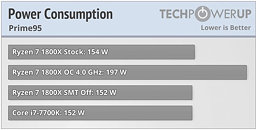
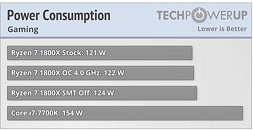
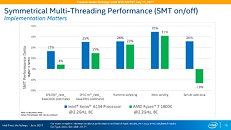
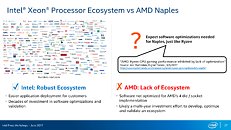
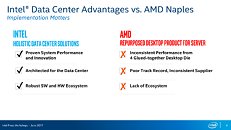
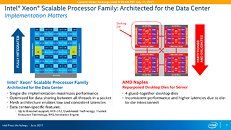
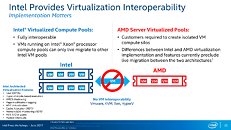
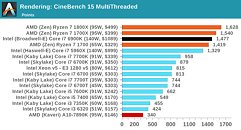
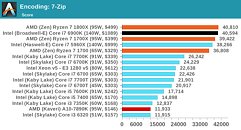
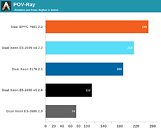

159 Comments on Intel Says AMD EPYC Processors "Glued-together" in Official Slide Deck
There's making profit and then there's straight up raping your customers. Intel is doing the latter.
It's totally confusing, just look at the x299 platform and these slides to figure it out.
THx AMD
AMD took the same old MOAR COARS approach as of old. Luckily this time they included better ipc, properly working SMT, and actually quite good power consumption at stock.
If you want tmobil comparison I guess that's fair. You get a value product. Alas you get what you pay for AMD right now works with a handful of ram kits and not at full dimm loads, has a lacking motherboard selection, and still AMD hasn't brought out apus. Just like tmobil with their shoddy service.
You don't want people to be able to buy a server CPU for less money?And this is a huge shock, because you haven't seen anything like this before, ever!
When you go to a car dealer and you ask for 100 HP more or leather seats, they'll give it for free.So differentiating price by disabling cores or limiting frequency is OK, but doing it by cutting features is not acceptable for you, right?
Why is that?
Just because others do it doesn't make it right.It is TDP and salvage die/binning based segmentation. One is artificial, the other is making the best of the dies you have.
Also... Useful for server workloads that are licensed by core count.
You don't pay for cores you don't need and you still have the full 2TB of memory per chip.
At the full frequency on the $400 part.
I suppose, though, that Intel is trying to get rid of the failures from production, but it sounds like AMD is trying to end that practice, too.
Am I really seeing this?
Your broken analogy not mine.
bundling things you need with things you don't to force you up a level.
Vs simple die salvage /tdp binning
Frankly I am astonished you think it's ok and that you can't seem to grasp the difference between crippling a die for artificial segmentation and salvaging dies.
I didn't mean bundling, but you're right - it's a common practice in car industry (and many others).
But calling this a dirty practice is really a misunderstanding.
You're criticizing something you should be grateful for.
Car manufacturers offer large customization to cover a wide range of needs and budgets. This is actually a great thing for the customers and a pretty big problem for the manufacturer.
Still, they have to make a profit, so they impose some limits.
You'd rather have a limited choice or none whatsoever? :)
Keep in mind that a narrow customization always results in a higher entry price.
AMD EPYC offering is very simple and straightforward. Intel has few times more CPUs with multiple choices possible.
So for example, you can get a version of a CPU that can utilize 768GB or 1.5TB of RAM and there is a significant price difference. If there was just a single variant, it would have to be priced somewhere in the middle. I like this choice. :)
www.anandtech.com/show/11544/intel-skylake-ep-vs-amd-epyc-7000-cpu-battle-of-the-decade/22
Intel is acting like a 3 year old in the middle of a tantrum.
Or you can pay $400 and have a chip that supports 2TB of ram. I like this choice.
If there was a single variant.... you would still pay whatever intel charged you because you don't see the big picture.
And here we're not talking about this, but about the massive amoung of Xeon variants, aren't we?
Because the way I see it, Intel's pricing on this Xeon lineup shows their fairly confident about the performance, features or robustness of the platform.
We're seeing this in other segments. 7700K and R7 1700 are meant for gaming and they perform similarly in gaming. The price is similar and they both sell pretty well.
It seems to be the same with TR. Again, CPUs match pretty well in price vs performance in productivity tasks, but not in cores (since the single-core potential is significantly different). As we're used to by now, AMD is 10-20% cheaper in most cases.
Now we jump to the server segment and bang: Xeons are twice as expensive as correspponding EPYCs - at least when matched based on cores and early leaked performance (the difference in clocks is not very significant).
I assume Intel wants to keep the profits they are used to, so for me this looks like a bad sign for EPYC. There has to be some task this platform isn't very good at - something that would make Intel feel fairly safe. I don't think AVX-512 advantage is enough.
I think that it's great for consumers.
I recommend people to wait with build but somehow they hurry up to be early adopters.
There is chance to buy i9-7900X for i7-7820X price after Threadripper show up.
If they decide to buy Intel after Threadripper performance beat their processors with 8-10 and 12 cores.
This is about what you offer in the basic package at the price you ask for it, and whether it comes across as a good deal or a straight up rip-off where every basic thing is monetized in front of your eyes.
It is very easy to see what is an artificial limitation just to create price differentiation, and what is a realistic limitation because the silicon simply becomes more expensive to make. L3 cache, cores, that's realistic. Instruction sets? That's borderline criminal.